Our Main Character Study Packet was just added to Teachers Pay Teachers and Teachers Notebook!
Our Comprehension Studies at a
Glance
In Grade 1 we use our Reader’s Workshop
time to introduce a Common Core comprehension studies. Our first grade progression
of story element studies start with the setting in October, the main character
in November, the problem and solution in December, and story mapping to put it
all together in January. In January after studying story mapping, we move on to
taking the story elements a little deeper and work on developing the
identification and discussion of beginning, middle, end, and events to get us
there. In February, we start to transition students into using a Reading
Response Journal. After months of studying the story elements, students know
what to write a response about. We also go deeper about discussing the main
character and other characters in text. At the beginning of our studies, we
have found the students are not really ready to go deep with character traits
and deeper inferences. We have found great success with focusing our objectives
on identification of the main character and telling how they knew that….to go
back to the text and explain why they are the main character. If we jump in too
far too fast, we find that most students struggle with the skill later on. We
do add the deeper layer for students who are ready in small group when
appropriate, but most of the students benefit from practicing identification of
the main character, how they knew that, how that character felt at one point
during the story and the antecedent that made them feel that way. The graphic organizers that go with our
studies, help students to truly know what they should discuss or write about to
show they understand text. It helps them organize their thinking and go back to
the text to cite the evidence that helps them identify and discuss the story
elements.
We study the Main Character second in
our list of story element reading endeavors. When we move onto the Main
Character, we read a few books that have prominent main characters and fit our
formula for identifying the main character of a story before the study begins.
We model, model, and model with mentor texts before we have students interact
independently with their own texts. We model thinking about the story element
we are going to introduce during our read aloud/think aloud time prior to even
introducing the element study. For example, during any read aloud before our
Main Character study, I will notice different clues in text and pictures that
may tell me who the most important character is. I tell students I am able to
show I understand what is going on in the text by being able to talk about who
is most important in the story. This also works with any story element study.
We do several interactive read alouds with different texts that we have found
to be helpful in first discussions with young readers about the Main Character.
In this zipped
file you receive everything you need to teach a Common Core Unit on studying
the main character in a first grade classroom.
There are seven different lesson plans set up in the Reader’s
Workshop Model of minilesson, meeting, connection, teaching point, active
engagement, independent reading, conferencing, and share. The lessons can be
used from a 2 – 3 week period and done over more than one day.
There are lessons for interactive read alouds to introduce and
practice engaging students in the identification of the main character in a
story.
There is a list of mentor we have found success when studying the
main character.
Anchor Charts in Smart Board file
and on hard copy as posters.
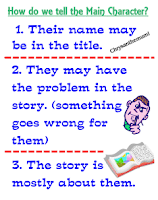
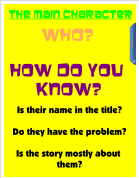
There are anchor charts already created for you that are colorful and engaging. The anchor charts are in a Smart Board File that is editable if you have a Smart Board. There are also hard copies of the anchor charts that can be tile printed pdf posters that you can put together and write on as you see fit if you don’t have a Smart Board. These can be posted in your classroom. There are also copies of the anchor charts in an 8 ½ by 11” format if you’d like to reuse them in small group instruction or copy packets for your students to keep with them. There are three different anchor charts for different lessons. The first describes what the main character means and why it is important to tell about it. The second is a chart that tells the criteria students can use to help identify the main character. The third is a discussion chart for using past mentor texts. The next two pages of the Smart Board file are large copies of the graphic organizer to model for the students. One they can use as a model for themselves. You can use the large poster version also to write on and post in your classroom for support. The last chart is the rubric used for the Main Character organizer. There is a lesson on how to use this effectively to teach students to begin looking at and assessing their own work. The rubric can be printed in both 8 ½ by 11” or tile printed as a poster to hang in your classroom.
Also included in this file is a banner to display of student work
and a poster that states the chant used to help students remember what the main
character is.
What’s great about this pack is it almost a ‘blank’ format for
students to learn the content through. We have similar things for the other
story elements so once the students learn this type of process, you can filter
the content through.
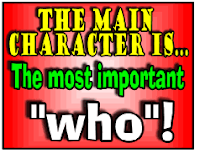 |
| chant sign, both large and small |
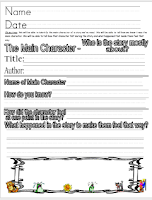 |
Organizer in both 8 1/2 by
11" student copy, in the
Smart Board file, and
included as a large poster.
|
The goals for this unit is for students to identify the main
character of a story using specific references to text. The Common Core for
first grade focuses on students being able to go back to the text to cite
specific evidence that helped them draw their conclusions. This unit focuses on
and practices that skill. They start whole group, then it filters down to small
group and finally independently. Some students may be able to do the more
intricate independent work at this point, but the unit differentiates itself so
all students are successful. This is the beginning. We are giving students a
lesson in how to organize their thinking. We are teaching them how to show they
understand text. We tell them
to show they understand. This is one way for them to experience success at
showing they understand.
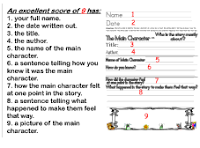 |
| rubric large and small |
 |
| banner to display student work |

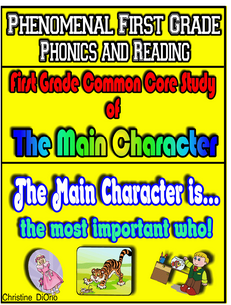
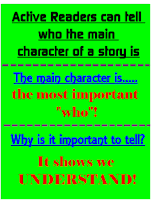
No comments:
Post a Comment